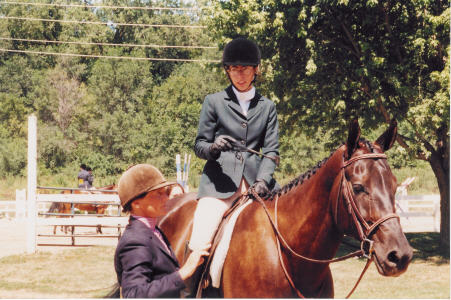
THE PROGRAM:
We cater to people who want to ride and show Hunters and Jumpers, although a riding academy is a fine place for anyone to learn responsibility and nurture their love for animals, even if it is not their goal to compete. We do not take in boarders from any other discipline (ie. western, dressage, etc.). We attend USEF rated horse shows on the INHJA (Iowa/Nebraska Hunter Jumper Association) circuit in Zone 6, and the IHJA (Illinois Hunter Jumper Assn.) circuit in Zone 5, and non-rated shows on the MIHJA (Midwest Hunter Jumper Association), as well as clinics (our favorite clinician is Karen Healey). We have held up to 10 shows at our barn each year (Winter Schooling Series Dec-Apr, 3 MIHJA shows and 2 USEF Rated shows), and we host a clinic every November. We also run a summer camp (horse care in the morning and a riding lesson in the afternoon) for people who have never ridden before to intermediate and advanced riders. We train and sell show horses. Videos of sale horses are available on the Sale Horses page.

Jan giving some last minute advice to student, Leslie Sommer, before she goes in the ring at her first Rated show.
This sport can be broken down into three categories: hunters, jumpers, and equitation.
In hunter classes, the horse is being judged. Much like figure skating and gymnastics, it is judged subjectively. A horse jumping in perfect form would bring his knees up evenly and squarely in front of their chest (the higher they bring their knees, the better) with their head slightly down, rounding their topline or "bascule". Judges also look at the horse's movement. Hunters should keep their feet skimming close to the ground, with as little knee action as possible. The courses that they jump typically include 7-9 jumps that are in 4 sets of jumps lined up with each other with a set number of strides between. A hunter should take the correct number of strides between the jumps in each line and make them all look smooth and even.
Jumpers typically have a longer, twistier course that is judged objectively. Show jumping is an Olympic sport and can also be seen on cable television channels like ESPN. Exhibitors are given a "time allowed" which is the maximum length of time they can take to complete the course without getting time faults. If they knockdown a jump (or part of it) they will incur jumping faults. If they refuse a jump, they will incur jumping faults. If they make it around the course without any faults they have what is called a "clean" round. All horses with a clean first round will do a second round as a sort of tie-breaker round called a "jump off" over a similar course over fewer fences and the winner is the horse with the fewest faults and the fastest time.
Equitation classes are judged on the rider's performance. Like hunters, it is judged subjectively based on specific guidelines. The riders should carry themselves in good posture, with their shoulders back, eyes ahead, heels down, back of the heel directly under the hip, etc. Good equitation actually has many components and takes a lot of practice to appear natural and not stiff and "posed". A good equitation rider spends a lot of time riding without stirrups to remain tight and balanced in the saddle and not loose and floppy. Each horse show we attend and host offers all three of these types of classes.